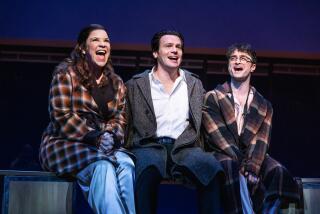OUTRAGE--AND LOVING IT
James Coco, one of the more distinctive actors in the American theater in word and the flesh (he admits to once having weighed 350 pounds), opens tonight in Royce Ryton’s “The Unvarnished Truth” at the Center Theatre Group/Ahmanson.
“It’s just an absolute panic,” he said on the telephone from Denver, on an anticipatory high over bringing the show to Los Angeles. “I play the frantic literary agent of a murder-mystery playwright (John Ritter). The bodies of accidentally murdered women start piling up in his house. It’s a true farce--people coming in, confusion, fast-forward movement. I play outrage. I love to play outrage.”
Coco, 55, who began his lengthy career after graduating from high school in the Bronx, is seen locally for the most part as a television actor and talk-show bon vivant (he’s finished his second cookbook), and is a natural for comedy. But he’s quick to point out that he relishes dramatic roles as well. “I played ‘Diary of Anne Frank’ and ‘The Transfiguration of Benno Blimpie,’ and I won an Emmy for playing a bag man on ‘St. Elsewhere.’ I enjoy drama, and I enjoy theater in general. Elaine May, Terrence McNally and Neil Simon have written for me. I love the breathing audience.”
Audiences who breathe Southern California air see precious little of Coco, however. (His last local appearance was in the CTG/Mark Taper Forum production of McNally’s “Adaptation/ Next,” directed by May.) “I love New York. When I’m away, I miss the weather, and the camaraderie.” (It was through a chance remark at Sardi’s, where he mentioned to friends how much he admired Ritter, that “The Unvarnished Truth” came his way.) “I’m a night person. In L.A., if you go to a diner at night, you meet the dregs. In New York, if I’m doing a show that lets out at 11, there are still plenty of places to go. I like to go prowling.”
Indeed, in New York, night prowling isn’t considered as suspicious an exercise as it is here. Who’d notice?
“It’s funny, it’s gruesome, it’s Duerrenmatt.” That’s director Martin Magner’s note for Duerrenmatt’s “The Meteor,” just opened at the Estelle Harmon Theater. “A Nobel Prize-winning writer has been left for dead in a clinic, but returns to his studio,” Magner went on. “Some people have trouble living--this one has trouble dying. He’s a fatalist and an atheist. The play is philosophically exhilarating. It was first done by the Royal Shakespeare Society in 1968; it’s since been rewritten. I’m not sure that it’s not an American premiere, but I do know it’s never been done on the West Coast. It’s timely, because the comet is coming.”
Magner is 85. As George Burns says, he’s older than a lot of countries. And maybe a meteor or two as well. These are not the best of times for the reputation of the late Ernest Hemingway. The name Hemingway itself is popularly known now as brandished by Mariel and Margaux, and those who remember the Papa persona tend to dismiss it as a paradigm of macho bluster.
Still, there’s much to be said for a lot of the cool, brook-clear prose of one of America’s literary giants, and much to be said too for the sensibility that coined the phrase grace under pressure and counseled the virtue of keeping your mouth shut. Actor Erv Johnson will be bringing us his Hemingway portrait, warts and all, when he arrives Friday with his “E. Hemingway” at the Off-Ramp Theater.
“I wrote it a couple of years ago and first showed it in Sun Valley, but it’s only recently that we’ve pulled it together,” said Johnson from Boise, Ida., where he lives and works as a regional theater actor. “Like the plays you see with Hal Holbrook and James Whitmore, it’s a dialogue with the audience, and in this case, a dramatization of some of the incidents of his life, such as the running of the bulls at Pamplona, his wartime experiences and his deep-sea fishing.
“The piece makes no apology for his strongly masculine persona. It pulls no punches in regard to terminology either. My wife, Ginger Scott, who directs, didn’t want to do it at first; she couldn’t accept the kind of personality he was. But eventually I convinced her that he was the expression of an era. We can understand what it’s like these days for someone to devote as much time to one’s public figure as to one’s art. Hemingway had no use for anybody he thought weak. But he wasn’t a phony. He lived the way he believed.”
More to Read
The biggest entertainment stories
Get our big stories about Hollywood, film, television, music, arts, culture and more right in your inbox as soon as they publish.
You may occasionally receive promotional content from the Los Angeles Times.










